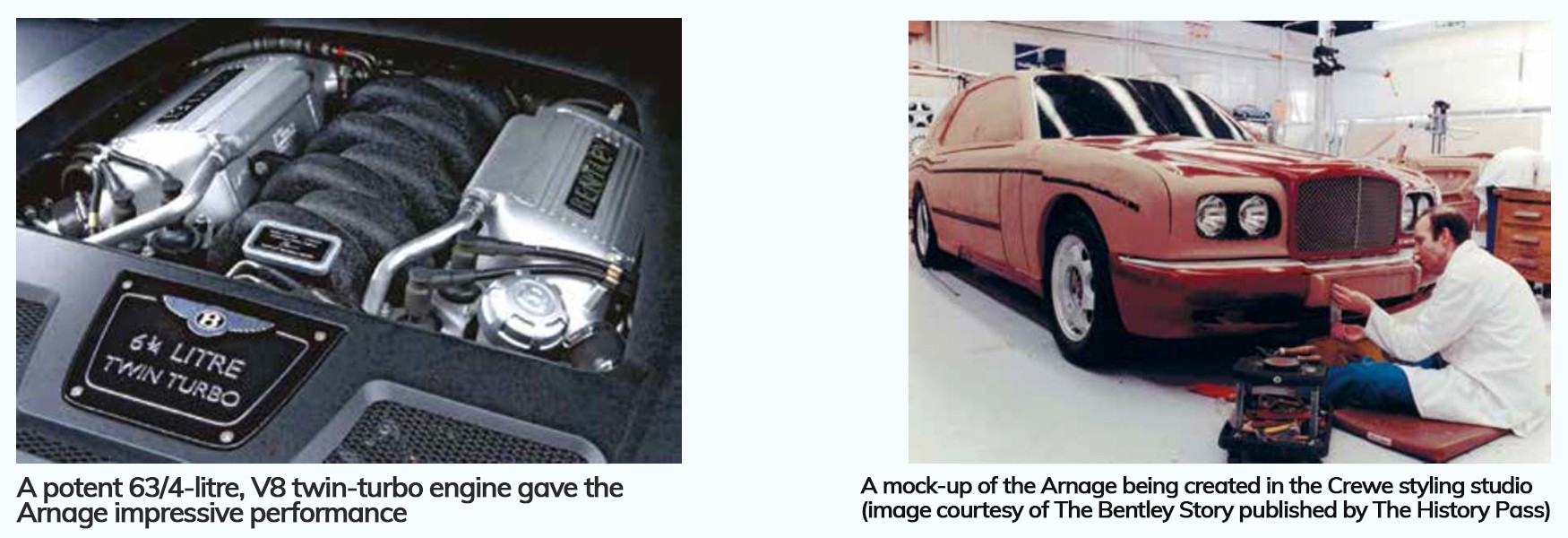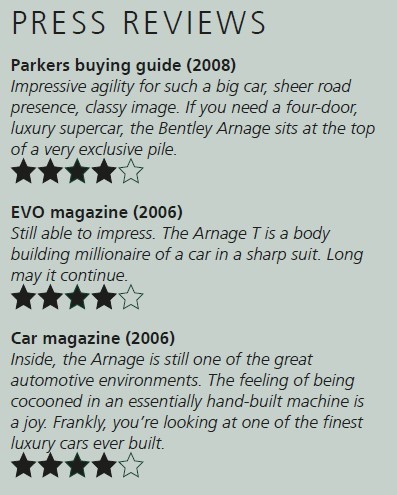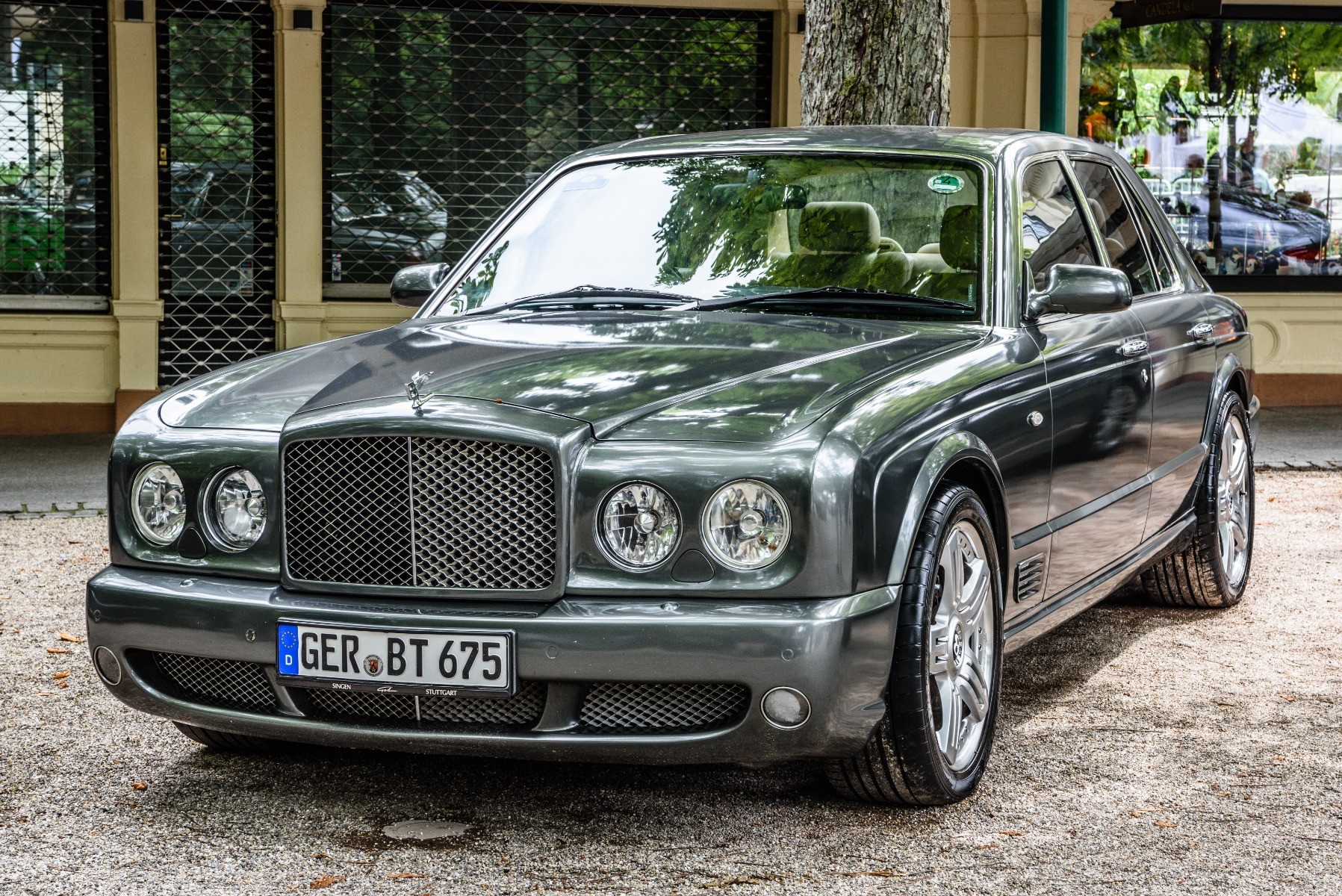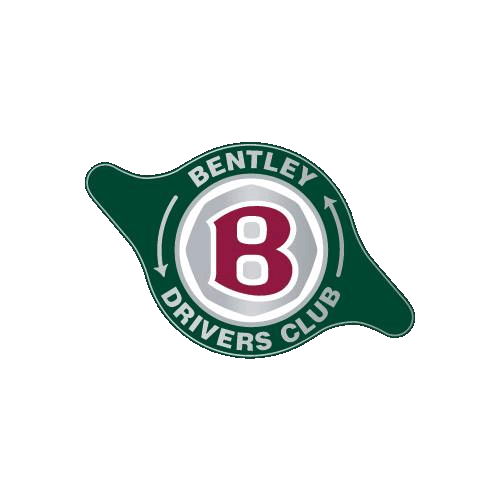
Twenty five years ago, in 1998, the Arnage was born and, during its 11-year lifespan, established itself as one of Bentley’s finest executive models. Review pays tribute to this luxury leviathan. Images from Review archives and courtesy of The History Press
As many keen motor racing enthusiasts will know, the Arnage shares its nomenclature with the slowest corner on the legendary Le Mans circuit, the section of track, itself, named in honour of a nearby district. Indeed, and somewhat appropriately, the Arnage received its official unveiling at the circuit which had been the scene of much of Bentley’s motorsport success in the late 1920s. However, as many Arnage owners will testify, the four-door model is curiously ill-named because the Arnage was, and remains, anything but slow. Capable of travelling at a quoted 180mph top speed at its peak – after undergoing a Sheer road presence’ married to a ‘classy image’ defines the Arnage significant mechanical upgrade for 2007 – the Arnage (in T version form) produced a stirring 500hp at 4,200rpm, making it capable of hitting 60mph from a standing start in just 5.2 seconds. Propelling this beast was a mighty 6.7-litre V8 twin-turbo powerplant.
They’re the bald figures. But, as any owner will tell you, the model is about far more than mere speed. As with all modern day Bentleys, the Arnage was a byword for absolute luxury and prestige. To put the model’s place in history into context, the Crewe built Arnage was the successor to the Brooklands and Turbo R models, and was the first new Bentley introduced, in April 1998, following Volkswagen’s purchase of the marque earlier that year. The Arnage signalled the first entirely new design for 18 years (despite styling cues taken from the legendary S1), and possessed the first complete body to be built at Crewe. It also boasted adaptive suspension and stability control, and hi-tech instruments.
A new engine was also initially planned, as a further break from the old days: a 4.4-litre BMW V8 twin-turbo motor developed by Cosworth Engineering, a subsidiary of Vickers, Bentley’s then owners. However, with VW having taken control of Bentley in 1998, the parent company opted, after two years, to replace the BMW engines with the venerable 6¾-litre, 16-valve, single turbo units previously used in the Turbo R; unfortunately, the engine was thirsty, failed to meet government emissions standards and was mated to an outmoded four-speed automatic transmission. Development: Red Label and Green Label Revisions were wrought. The results were two revised versions of the Arnage, both of which enjoyed stiffer body shells, and larger wheels and brakes. The Red Label (1999) used the improved 6¾-litre engine; it also enjoyed the distinction of being the torquiest four-door in the car market at the time, and was seen as the stablemate to the Continental R and T coupes as well as the Azure convertible. The Green Label (2000) deployed a modified version of the original BMW powerplant. Just seven Green Labels, all left-hand drive, were built along with 52 limited edition Arnage Birkins.

Series Two: RL ‘limousines’
Series Two of the Arnage saw the introduction of the RL ‘limousines’ (2001) – long-wheelbase bespoke versions boasting a larger rear area and, crucially, enhanced performance and reliability thanks to an upgraded 6¾-litre V8 engine, now with potent twin turbos. Reflecting its clientel it had armour plating and bullet-proof windows. Incidentally, a unique RL was rolled out in 2002 – the Bentley State Limousine, the official state car of HM the Queen on the occasion of her Golden Jubilee that year.

R and T
There followed (in 2002) the R and T, the former succeeding the Red Label with the latter being sportier and slated, on its launch, as the most powerful car in the Bentley portfolio, hitting a (claimed) top speed of 170mph and 0-60 in 5.5secs. The Arnage took a significant step forward in 2007 when the model benefited from a major mechanical upgrade. The engine was married to a six-speed automatic gearbox (as used in the Continental range) and the cubic capacity slightly increased – affording the R an improved 460hp and the T 500hp.



Le Mans Series
Aside from these versions, two limited edition Le Mans Series cars were produced to celebrate the marque’s return to the 24-Hour classic in 2003 after 71 years’ absence: 50 LM editions of the Continental R Mulliner and 150 of the Red Label plus five Continental T LMs and four Azure LMs.
Diamond Series
Sixty Diamond Series models were also rolled out in 2006 to mark 60 years of production at the Crewe factory. These magnificent models featured diamond wood inlays, diamond quilted leather seats, a stainless-steel bumper, 19-inch alloy wheels and Union Jack wing badges.
Final Series
To mark the end of Arnage production in 2009, a run of 150 Final Series models was built – boasting the T’s powertrain, including the much vaunted 6¾-litre V8 twin turbo engine driven by a six-speed auto gearbox. Among the special features were 20-inch alloys, a retractable Flying B mascot, jewel-style filler cap and special badging. The Mulliner-styled interior boasted drilled alloy pedals, chrome trim, rear cocktail cabinet and picnic tables. With the end of the Arnage, the model was succeeded by the Mulsanne in 2009.
Written by Richard Edgell. Images: Courtesy of WOBMF and Neill Fraser
Thank you to the Bentley Drivers Club (BDC) for giving us kind permission to use this article on our website.
Become a member of the Bentley Drivers Club today, visit www.bdcl.org/membership


